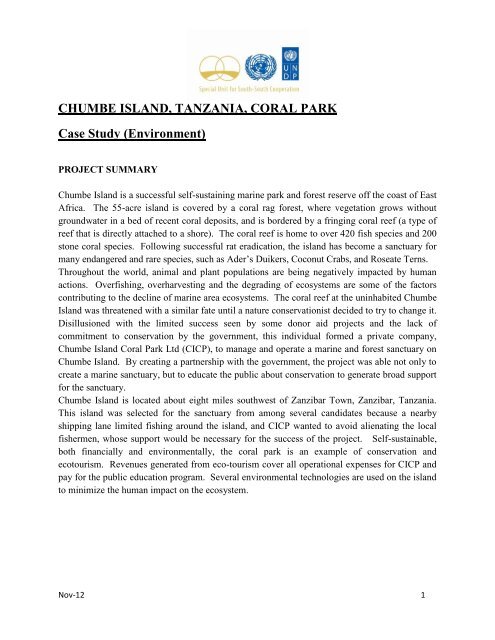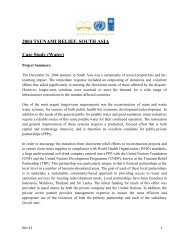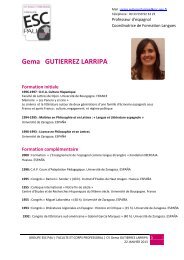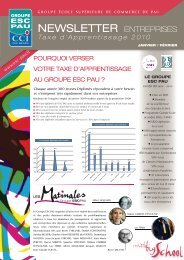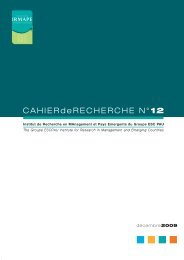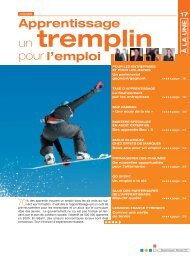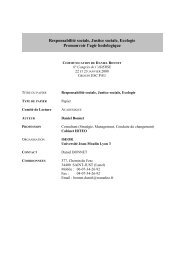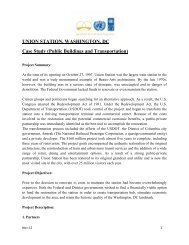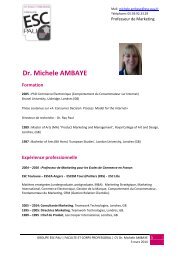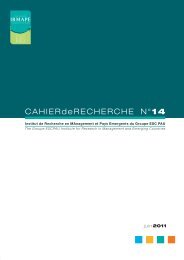Chumbe Island Coral Park (Zanzibar, Tanzania) - ESC Pau
Chumbe Island Coral Park (Zanzibar, Tanzania) - ESC Pau
Chumbe Island Coral Park (Zanzibar, Tanzania) - ESC Pau
Create successful ePaper yourself
Turn your PDF publications into a flip-book with our unique Google optimized e-Paper software.
CHUMBE ISLAND, TANZANIA, CORAL PARKCase Study (Environment)PROJECT SUMMARY<strong>Chumbe</strong> <strong>Island</strong> is a successful self-sustaining marine park and forest reserve off the coast of EastAfrica. The 55-acre island is covered by a coral rag forest, where vegetation grows withoutgroundwater in a bed of recent coral deposits, and is bordered by a fringing coral reef (a type ofreef that is directly attached to a shore). The coral reef is home to over 420 fish species and 200stone coral species. Following successful rat eradication, the island has become a sanctuary formany endangered and rare species, such as Ader’s Duikers, Coconut Crabs, and Roseate Terns.Throughout the world, animal and plant populations are being negatively impacted by humanactions. Overfishing, overharvesting and the degrading of ecosystems are some of the factorscontributing to the decline of marine area ecosystems. The coral reef at the uninhabited <strong>Chumbe</strong><strong>Island</strong> was threatened with a similar fate until a nature conservationist decided to try to change it.Disillusioned with the limited success seen by some donor aid projects and the lack ofcommitment to conservation by the government, this individual formed a private company,<strong>Chumbe</strong> <strong>Island</strong> <strong>Coral</strong> <strong>Park</strong> Ltd (CICP), to manage and operate a marine and forest sanctuary on<strong>Chumbe</strong> <strong>Island</strong>. By creating a partnership with the government, the project was able not only tocreate a marine sanctuary, but to educate the public about conservation to generate broad supportfor the sanctuary.<strong>Chumbe</strong> <strong>Island</strong> is located about eight miles southwest of <strong>Zanzibar</strong> Town, <strong>Zanzibar</strong>, <strong>Tanzania</strong>.This island was selected for the sanctuary from among several candidates because a nearbyshipping lane limited fishing around the island, and CICP wanted to avoid alienating the localfishermen, whose support would be necessary for the success of the project. Self-sustainable,both financially and environmentally, the coral park is an example of conservation andecotourism. Revenues generated from eco-tourism cover all operational expenses for CICP andpay for the public education program. Several environmental technologies are used on the islandto minimize the human impact on the ecosystem.Nov-12 1
Project ObjectivesThe first objective of CICP was to create a reef sanctuary and forest preserve. In this way,<strong>Chumbe</strong> <strong>Island</strong> would become one of the last undisturbed “coral rag’ forests in the world. CICPwanted to maintain and foster greater biodiversity around the coral reel and in the forestpreserve.A second objective was to apply business management skills to create and follow a model ofsustainable conservation management, which would be supported by ecotourism. Operationalexpenses would be covered by revenues from ecotourism. Sustainable management alsoincluded building and maintaining environmentally friendly buildings. All the buildings on theisland—a visitor center and bungalows for overnight stays—would be designed and built withthe up-to-date eco-technology, using local materials, and would be self-sustaining. Revenuefrom ecotourism would be used to manage the coral park and support environmental educationfor local students.A third major objective that helped make the first two objectives possible was to educate thepublic about the need for conservation. Local residents believed corals were just rocks and sofishermen overfished and practiced destructive fishing techniques, which were decimating thecoral reefs. The local language Kiswahili has no word for corals and despite a number of coralreefs in <strong>Tanzania</strong>; school curricula did not cover coral reef ecology. Educating not justfishermen, but school children and communities about the need for conservation, helps ensurethese areas remain protected. A goal was to increase the general public’s awareness of theimportance of the coral reefs.Nov-12 2
Project Description:1. PartnersThe public sector partner of the PPP is the Revolutionary Government of <strong>Zanzibar</strong>, the politicalbody which oversees <strong>Zanzibar</strong>, the semi-autonomous region of <strong>Tanzania</strong>. The RevolutionaryGovernment maintains ownership of <strong>Chumbe</strong> <strong>Island</strong>, with the <strong>Zanzibar</strong> Ministry of Agriculture,Livestock, and Natural Resources and the <strong>Zanzibar</strong> Ministry of Lands and Environment as theagencies with direct oversight of the project.The private sector partner is <strong>Chumbe</strong> <strong>Island</strong> <strong>Coral</strong> <strong>Park</strong> Ltd (CICP). The company was createdby a former donor-aid worker to manage and operate <strong>Chumbe</strong> <strong>Island</strong>. The initial capital for theproject was provided in part by the company and in part by eco-friendly donors.2. Implementation Environment - Legislative and AdministrativeCICP went through a number of steps in order to begin operations on <strong>Chumbe</strong> <strong>Island</strong>. Theprivate company approached the government and presented an unsolicited bid for theestablishment of a marine sanctuary and forest preserve, which the government accepted.Typically in <strong>Tanzania</strong>, land tenure for foreign citizens and organizations is only availablethrough leaseholds and are based on proposals from the citizens or local organizations. Afterextensive discussions, in 1993 CICP was granted a lease for its eco-facilities and visitors’ center,which were built on 5.9 acres.In 1994, the <strong>Chumbe</strong> <strong>Island</strong> Reef Sanctuary and the <strong>Chumbe</strong> Forest Reserve were “gazetted” bythe Revolutionary Government of <strong>Zanzibar</strong>. The term “gazette” is used when the governmentofficially declares and makes a law by publication in the Government Gazette. Under thedeclaration and law, CICP was granted exclusive management rights of the reserve and sanctuaryfor the length of time specified in the contracts.3. Financial AgreementThe initial capital investment of US$1.2 million came from several sources. About two-thirds ofthe amount was financed privately by the project initiator, who is a conservationist and formermanager of donor-funded aid programs. Other academic, environmental, and conservationgroups helped provide the remainder of the capital investment. The project took seven yearsNov-12 3
from inception to completion due to the challenges of dealing with the government bureaucracy.These delays caused initial costs to increase.Operation and maintenance costs are between US$150,000 and US$200,000 per year. Since2000, <strong>Chumbe</strong> <strong>Island</strong>’s operations have been fully sustained through ecotourism. The revenuegenerated through small-scale ecotourism covers the costs of managing the Marine ProtectedArea, research projects, conservation, and free education programs for local schools. Day tripsto <strong>Chumbe</strong> <strong>Island</strong> are US$80 per person per day and overnight stays are US$165-US$250 perperson per night (2008 prices).The financial goal of <strong>Chumbe</strong> <strong>Island</strong> is not to generate a profit, but to be both financially andenvironmentally self-sustaining. Currently, the amount of visitors to the island is only 40 percentof capacity, but sufficient to cover all operational expenses. If full capacity is reached, there isthe potential for recovery of the investment capital or limited expansion in some areas (fullcapacity would mean 14 overnight guests and 12 day-only guests). However, CICP feels that thelevel of use of the facilities must be weighted against the primary objective of environmentalpreservation.4. Contract ProvisionsIn 1994, CICP entered into management and operation contracts with the RevolutionaryGovernment of <strong>Zanzibar</strong>. One contract was to manage and operate the marine sanctuary for 10years and the second was to manage and operate the forest reserve for 33 years. The marinecontract was renewed in 2004 for another 10 years, upon expiration of the original contract.The land lease granted in 1993 for the visitor center and eco-bungalows is for 33 years. Thegovernment retains ownership of the marine sanctuary and <strong>Chumbe</strong> <strong>Island</strong>, including the forestreserve and the visitor center and bungalows. Ownership of wildlife is always in governmenthands and the government retained ownership of the island, despite the common practice ofreferring to <strong>Chumbe</strong> <strong>Island</strong> as a “private island”. This misconception exists in certain quartersbecause <strong>Chumbe</strong> <strong>Island</strong> is managed by a private company.5. Implementation MetricsCICP has created a marine park and forest reserve on <strong>Chumbe</strong> <strong>Island</strong> that conserves theecosystem. In 1993, baseline surveys and flora and fauna species lists were conducted as a guideto the state of the island prior to granting protective status. On-going studies, conducted by theNov-12 4
Institute of Marine Sciences at the University of Dar es Salaam, show that fish families are of agreater size and abundance inside the protected areas compared to other area reefs. Localfishermen respect the no fish zones, allowing these areas to be breeding grounds. Today thecoral reefs in and upstream from the marine park have been restocked. In addition, through workwith zoos and universities, several endangered and rare species now make their home on<strong>Chumbe</strong> <strong>Island</strong>. The endangered Aders' duikers were successfully relocated to <strong>Chumbe</strong> <strong>Island</strong>from their original habitat of the East African coastline and <strong>Zanzibar</strong> <strong>Island</strong>.CICP has created a self-sustaining conservation project—both financially and environmentally.Visitor fees for ecotourism on <strong>Chumbe</strong> <strong>Island</strong> cover operational costs and fund the educationalprogram for local school children. CICP has employed various techniques that conserveresources and limit the human presence on <strong>Chumbe</strong> <strong>Island</strong>, which minimizes the disturbance tothe ecosystem.All the buildings on <strong>Chumbe</strong> <strong>Island</strong> were developed with environmental technology, using localmaterials, and are self-sufficient. Techniques include rainwater catchment, solar water heating,photovoltaic power, composting toilets, and vegetative grey water filtration. All importantbuilding functions are covered by eco-techniques. Rainwater is heated by solar power and usedas shower water. Water use is reduced and sewage problems are avoided by using compostingtoilets. Biodegradable soaps are used to minimize water pollution and organic waste iscomposted. The vegetative grey water filtration system absorbs phosphates and nitrates beforethe water is released into the ecosystem. All of these techniques are used to reduce waste andpreserve the island’s environment.Commentary:1. Methods for Overcoming ImpedimentsThe greatest obstacle for this project was gaining stakeholder support. Conservation was not ahigh priority for <strong>Zanzibar</strong> and many government officials had difficultly grasping the value andimportance of the project. Marine protection was not an area of study for the government andcreation of a marine park was met with skepticism. CICP had to work with seven differentgovernment departments before the project was approved. However, by involving severalgovernment departments in the initial phases of the project, CICP helped people become morereceptive to the project. Today, more government officials understand the importance of projectconservation, and even passed environmental legislation in 1996 that allows private managementof protected areas.Nov-12 5
CICP also worked hard to gain the support of area fishermen and other local residents. Villagemeetings were held before and during project development to include local communities in theplanning process. Local fishermen were also recruited to become park rangers, and help enforcethe fishing prohibition at the reef. A <strong>Park</strong> Advisory Committee was created and is composed ofgovernment, university, and village representatives so that all groups are able to influence andcontribute to the project.Educating local residents about the importance of conservation is not the same thing asincorporating conservation into daily routines. Many local residents rely on fishing for theirlivelihoods and do not fully understand the destructive nature of some of their techniques (forexample, the use of dynamite for fishing). CICP trained former fishermen, from nearbycommunities, in basic reef ecology and marine biology, visitor guidance, and communication.The former fishermen enforce park regulations and monitor the reef and reserve, as well as playa critical role in communicating with area residents. The park rangers are more credible in theeyes of area fishermen because they understand the importance of this livelihood and promotethe conservation policies in terms they can understand. Local fishermen see the benefits of theno-take protected area as a breeding sanctuary because it helps to restock the adjacent fishinggrounds. By choosing local residents who are sympathetic and knowledgeable about areabusinesses and needs, CICP gained credibility and was able to implement their agenda, whichthey might not have been otherwise able to do. Local fishermen were able to translate theimportance of conservation into tangible benefits and are very respectful of the no-fishing zones.2. Key Points for Success or FailureSince its inception, over 2,500 students and 500 teachers have visited <strong>Chumbe</strong> <strong>Island</strong> toparticipate in the education program. Several schools have incorporated environmental studiesinto their curriculum, building on the knowledge and interest generated from a visit to <strong>Chumbe</strong><strong>Island</strong>. Through education programs and former fishermen turned park rangers, CICP has gainedtremendous support from local residents and fishermen. Conservation and wildlife preservationare now concepts that make sense to them and impact some personal decisions.<strong>Chumbe</strong> <strong>Island</strong> <strong>Coral</strong> <strong>Park</strong> is self-sustaining both environmentally and economically. CICPemploys many eco-techniques to make each of their buildings decentralized, self-sufficient unitsthat have little impact on the surrounding environment. By “practicing what they preach,” CICPemployees gain further support from local communities and students for their environmentalinitiatives because students can see the concepts they learned in action. Through effectiveNov-12 6
management, CICP was able to start with donor funds for the initial capital investment and useecotourism revenues to fund all subsequent operational costs.While at present the project does not have a financial scheme in place for CICP to recoup itscapital investment, there is a distinct potential to do this. Education programs are free for thelocal students – if CICP required a fee for the program, this could enhance their bottom line.Additional revenue could be generated from full occupancy by actively marketing <strong>Chumbe</strong><strong>Island</strong>. However, understandably CICP does not wish to expand the eco-tourism program to apoint where there would be negative impact on the environment of <strong>Chumbe</strong> <strong>Island</strong> <strong>Coral</strong> <strong>Park</strong>.Nov-12 7


